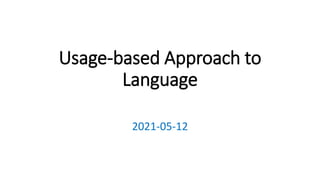
usage based model.pptx
- 2. Three guiding principles of Cognitive Linguistics Language is not an autonomous cognitive faculty. Grammar is conceptualization. Knowledge of language emerges from language use.
- 3. The nature of language
- 5. Usage-based language change • Change is seen not as a function of system-internal change, but as a function of interactional and social (usage-based) pressures that motivate changes in the conventions of the language system. • Bybee (2010: 1) argues: • When linguistic structure is viewed as emergent from the repeated application of underlying processes, rather than given a priori or by design, then language can be seen as a complex adaptive system. • 理科生之“难”
- 6. Usage-based language acquisition Evans & Green (2006: 111) has put: • Knowledge of language is derived from and informed by language use. Language acquisition is understood from this usage-based perspective not as the activation of an innately pre-specified system of linguistic knowledge (Universal Grammar), but instead as the extraction of linguistic units or constructions from patterns in the usage events experienced by the child.
- 7. Tomasello (2000, 2006) ‘s summary The linguistic skills that a person possesses at any given moment in time – in the form of a “structured inventory of symbolic units” – result from her accumulated experience with language across the totality of usage events in her life. This accumulated linguistic experience undergoes processes of entrenchment, due to repeated uses of particular expressions across usage events, and abstraction, due to type variation in constituents of particular expressions across usage events.
- 8. The Tinguely Machine by Schmid (2020: 4)
- 10. Pavlov’s Dog
- 12. Hebbian Principle • Hebbian theory is a neuroscientific theory claiming that an increase in synaptic efficacy arises from a presynaptic cell's repeated and persistent stimulation of a postsynaptic cell. It is an attempt to explain synaptic plasticity, the adaptation of brain neurons during the learning process. • 赫布理论解释了在学习的过程中脑中的神经元所发生的变化。赫布理论描述了 突触可塑性的基本原理,即突触前神经元向突触后神经元的持续重复的刺激, 可以导致突触传递效能的增加。 • The association between A and B can be entrenched by repetition.
- 13. The puzzle of “the +adj” • 问题的延伸 (如何“以小见大”) • 从一个底部问题出发(如何“一本万利”) • 从现象到理论 • 从个别到一般
- 14. Tomasello’s experiment • In the early stage of language learning[P. 447]
- 15. P. 448
- 16. Questions to be discussed: • Question I: • Many young children say things like “Her open it”, an accusative subject which they supposedly have not heard from adults. But children almost never make the complementary error “Mary hit I” or “Jim kissed she” . • Let her open it./ Help her open it. • End attention! • Recency effect vs. Primacy effect
- 17. Questions to be discussed: • Question 2: • Children hear a very large number of nonfinite verbs right after nominative nouns, especially in questions such as “Should he open it?” and “Does she eat grapes?” The child might then later say, in partially imitative fashion: “He open it” and “She eat grapes”. And Why?
- 18. Type frequency vs. token frequency • Which one is related to entrenchment of a construction? • Which is one is related to the productivity of a construction?
- 19. P.449
- 20. • What is constructional analogy?
- 22. P.453
- 23. Perspectives: • Three questions related new usage-based models: • (i) the units of language with which people operate are not presupposed or prejudged; • (ii) there is an explicit concern with processes of communication in usage events; • (iii) how human linguistic competence has evolved historically.
- 26. Principle of compositionality • The meaning of a sentence arises from the meanings of the words it contains, together with the way in which these words are syntactically arranged. • This gives rise to propositional meaning, a ‘purely semantic’ meaning that is independent of context.
- 27. It’s constructions all the way down. — (Goldberg, 2006: p.18)
- 28. When constructions are varying in size and complexity, do we need the division of lexicon and grammar?
- 29. A question as reviewing • A child can learn a language structure by limited exposures. For example, when he experienced the use of “goes, does, watches”, he may make the overgeneralization by putting the ending suffix of “-es” as the present tense markers to some words he haven’t met before, for example“*terrifyes, *supportes”; however, such misuses can soon be eliminated by himself. • Do you know the reason why? • Preemption